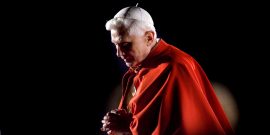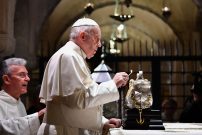Benedict always spoke of a “reason illumined by faith,” a dialogue that he believed characterized Europe at its best.
Consensus of the Conclave
Few elections command as much fascination as the secret conclave of cardinals gathering this week to choose the next pope. Catholics trust that the Holy Spirit guides this decision, yet the outcome still depends on carefully forged human rules. Chief among them is the centuries-old mandate that no candidate may be elected without winning the support of at least two-thirds of the electors. A mere majority does not suffice.
The history and function of this rule are both intriguing and revealing. The dynamics of a papal election are not comprehensible without understanding the rule. It also illustrates important truths about supermajoritarianism, which has a prominent place in secular politics, particularly in America’s own Constitution.
In the beginning, the College of Cardinals did not elect the Pope. Local clergy, laity, and neighboring bishops selected the Bishop of Rome. Monarchs of the area also influenced the election. But by the early part of the second millennium, the rules were set: the pope would be selected by a two-thirds majority of the college of cardinals.
The two-thirds rule has endured for centuries. Sometimes, it proved difficult for anyone to gain the requisite supermajority. Yet the church needed a pope, particularly as the bishop of Rome had become the ruler of a large part of central Italy—the so-called papal states. After the death of Clement IV in 1268, a lengthy stalemate lasted two years and nine months. It was resolved only when the infuriated locals of Viterbo—where the election was taking place—cut the cardinals’ food ration and then removed part of the roof from the place of their deliberation!
Soon afterwards, Gregory X made cutting rations part of the formal rules governing the conclave. If, after three days, the conclave had not selected a Pope, the cardinals would face an enforced diet. Though medieval in origin, the ration-cutting rule squarely tackles a real weakness of supermajority voting spotted by modern theorists: spiraling decision costs. James M. Buchanan and Gordon Tullock observed in The Calculus of Consent that as a voting rule demands greater consensus, the decision costs, including the time required to make the decision by persuading others, increase. Starving the electors is a dramatic means of forcing a quicker, though potentially sub-optimal, agreement.
Over time, the threat to the cardinals’ nutrition has disappeared. It is no surprise that the policy was very unpopular with cardinals and fell into desuetude, given that by its nature, there was no reigning pope to enforce it. John Paul II got rid of all previous conclave rules that he did not reaffirm, so it is not in effect today.
By contrast, the two-thirds majority rule has persisted to modern times. Today it is clear, as it was not in earlier times, both that votes are secret, and that candidates can vote for themselves. These two rules are intertwined: there would be no way to enforce a prohibition against boosting oneself because of the secret ballot. And given that candidates can now vote for themselves, the two-thirds requirement rounds up whenever necessary. Thus, for the 133 eligible cardinals well enough to attend the current conclave, the majority required is 89.
John Paul II introduced the conclave’s most substantive rule change in eight hundred years. He decreed that after 34 ballots, a majority of the conclave could elect a pope by a mere majority. The rationale apparently was fear that otherwise conclaves could go on and on—the same kind of concern that led to the food supply rule.
The sainted pope had many virtues, but he was not a game theorist. Game-theoretical analysis reveals that the change dilutes the supermajority safeguard and creates perverse incentives. One must reason backward from the final ballot to see how the lower threshold reshapes incentives from the conclave’s very outset. Given that a determined majority could elect its preferred candidate on the 35th ballot, the rule encourages such a faction to remain united through those early ballots in the expectation of getting their candidate when the majority is authorized to change the rule.
The rule might well also extend the length of conclaves, because such a majority would wait it out rather than finding a compromise candidate earlier on. It might be thought that it would be hard for a majority faction to stick together for 34 ballots. But because ballots occur four times a day after the first session, a determined majority could trigger the rule shift in only ten days. The church was fortunate that the 2005 conclave was the only time his rule was in effect, and then the substantial support for Cardinal Joseph Ratzinger made its salient differences from the traditional rule academic.
As Benedict XVI, Ratzinger proved more traditionalist than his predecessor. He changed the rule back to make the two-thirds majority requirement again apply throughout all the voting rounds of a conclave. After the 34th ballot under the new rule, which governs the current conclave, however, the cardinals would be restricted to the two front runners.
Even without claiming the Holy Spirit’s imprimatur, America’s supermajoritarianism carries moral weight: it obliges factions to seek partners and to temper victory with accommodation.
Benedict’s revision has complicated effects: by restoring a one-third veto, it encourages the cardinals to build coalitions early and to settle on compromise candidates. Because no easier threshold ever arrives, a faction must persuade rivals to achieve the two-thirds mark; it cannot merely wait them out. This makes strategies of simple obstinacy unadvisable. The runoff requirement means that if coalition-building fails early, however, the final choice may be difficult to resolve. A conclave could stalemate if the two finalists each have steadfast blocs opposed to each other. While Benedict’s rule eliminates the risk of a pope with only the narrow majority support that John Paul II’s rule made possible, it creates some risk of a longer interregnum without any pope.
Thus, Benedict’s rule is not obviously superior to the old rule, where compromise candidates continue to be possible at any point. The concern that traditional rule may lead to exceptionally long conclaves has not been borne out in modern times. The intense global criticism that the Church would receive from such prolonged indecision may well be sufficient to deter prolonged deadlock.
The two-thirds majority rule has many functions, some of which were more historically salient than now. Sociologically, its function remains existential: to avoid schism within the church by assuring that the winning candidate is broadly acceptable. The rule is the background of the famous Italian saying, Chi entra in conclave papa, ne esce cardinale: He who enters the conclave as pope exits as a cardinal. It is not enough to come with a crowd of intense supporters who have gotten your bandwagon going. A successful candidate needs backing from many different quarters, even ones that are cautious and silent.
Even in recent times, the supermajority rule has fulfilled its purpose of maintaining at least a façade of unity through compromise. In the second 1978 conclave, in early ballots, the conservative Archbishop of Genoa, Giuseppe Siri, faced off against the liberal Archbishop of Florence, Giovanni Bennelli. Neither could win a consensus, and so the result was the election of an alternative, more obscure candidate, Karol Wojtyła, as John Paul II.
This historic function is as important today as ever. To an outsider, the Catholic Church appears to be split between what seem to be liberal and conservative factions that are increasingly polarized, like much of the rest of our political world. The risk of the supermajority rule is that it may sometimes encourage candidates who paper over sharp differences and leave factions seething beneath the outward appearance of unity. Even so, from an institutional point of view, prolonged trimming is preferable to outright schism.
Theologically, the supermajority rule has an epistemic role. Believers may well credit a supermajority as better able to provide the moral certainty about the wishes of the Holy Spirit than a narrow majority. In making his change, Benedict XVI himself did admit, however, that even a supermajority was no guarantee of sound decision-making. There have been popes, like Alexander VI, whose character at the time of the election and performance in office may refute any simple conclusion that the Holy Spirit is always behind the choice.
The rule also had a political function—protecting the property and civil rights of those under papal rule. The two-thirds supermajority rule emerged as the pope became a powerful ruler of a large territory in the Papal States. Prospective changes in autocratic rule increase uncertainty among the citizenry as property and other rights may be changed under a new regime. Monarchies deal with this problem by heredity rule. Sons are likely to have similar interests to the current ruler. Moreover, they are known quantities around whom citizens can plan. That is one reason that monarchies lavish attention on the heir, sometimes giving him a special name, like the British Prince of Wales or the French Dauphin, and a substantial presence at court. Conversely, the absence of an heir can lead to instability in a kingdom. The hereditary principle helps ensure that the subjects feel their rights will be as secure as ever.
Of course, popes could not leave their office to their children. Nevertheless, a rule that required a supermajority made it more likely that there would not be radical shifts that would threaten rights. Mancur Olson, the great political economist, suggested that the broader the coalition that is required to hold power, the more encompassing is its interest. As a result, a broad coalition would internalize the costs of its policies and act in the general interest rather than exploit one faction in favor of another. As popes have lost secular power, this function of the papal supermajority rule has lost its importance.
But it is this latter function that most resembles that of supermajoritarianism in our own political system. Americans have constitutional rights that can be changed only by the strictly supermajoritarian amendment process—generally by a two-thirds vote of both houses of Congress and ratification by three-quarters of the states. Even ordinary legislation is effectively supermajoritarian because passage requires majority votes in two houses, elected in different jurisdictions and at various times, as well as the agreement by the president in the absence of two-thirds support. The Senate’s filibuster rule even makes the process more strictly supermajoritarian for most legislation.
The appropriate stringency of these secular supermajority rules is—and should remain—a matter for debate. Yet even without claiming the Holy Spirit’s imprimatur, America’s supermajoritarianism carries moral weight: it obliges factions to seek partners and to temper victory with accommodation. By compelling citizens to ask what they share, it transforms bare winners into broad coalitions and converts fragile majorities into more durable consent.



